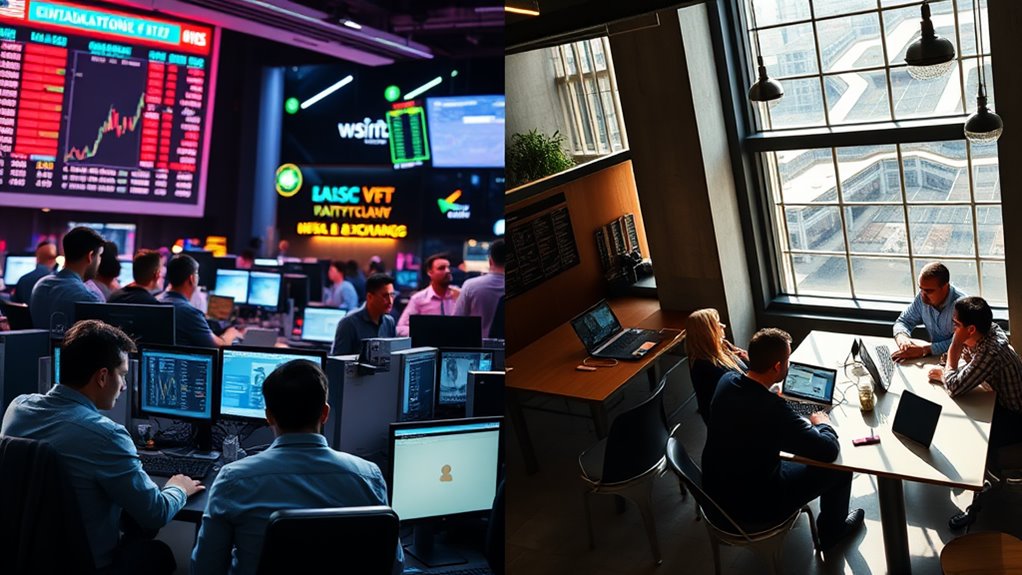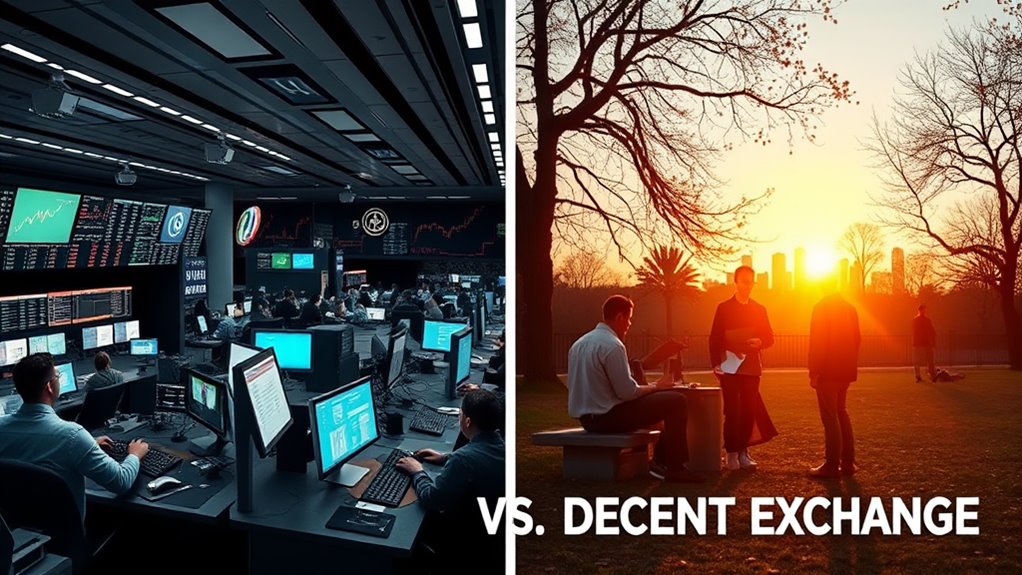
Centralized Vs Decentralized Exchange: Which to Choose?
When choosing between centralized and decentralized exchanges, individuals must consider their different features. Centralized exchanges offer user-friendly interfaces, high liquidity, and fast transactions, but have security risks and higher fees. Decentralized exchanges provide users with full control over their assets and lower fees, yet can be complex for beginners. Ultimately, the choice depends on the user’s trading experience and privacy needs. More insights can guide users towards making the best decision tailored to their preferences.
Table of Contents
Key Takeaways
- Centralized exchanges offer user-friendly interfaces and high liquidity, making them suitable for beginners and those seeking quick trades.
- Decentralized exchanges provide users with full control over their assets, reducing counterparty risk and enhancing security.
- Consider transaction fees, as centralized exchanges often have higher costs compared to the lower fees of decentralized platforms.
- Evaluate your trading experience; centralized exchanges cater to novices, while decentralized exchanges may appeal to experienced traders valuing privacy.
- Security measures differ; centralized exchanges face hacking risks, whereas decentralized exchanges eliminate custodial vulnerabilities but may have smart contract risks.
Understanding Centralized Exchanges

Centralized exchanges (CEXs) serve as key players in the cryptocurrency market, providing a platform for users to trade digital assets seamlessly.
These exchanges are managed by a single central authority, which controls user funds and manages private keys on behalf of users. Many CEXs offer direct integration with fiat currencies, facilitating easier access for newcomers to the crypto world.
CEXs are governed by a central authority that oversees user funds and simplifies access to cryptocurrencies through fiat integration.
To operate legally, they must comply with regulations such as Know Your Customer (KYC) and Anti-Money Laundering (AML) laws.
CEXs utilize automated systems for efficient order matching, ensuring high liquidity and fast transaction speeds.
Additionally, they provide user-friendly interfaces, customer support, and educational resources to assist users in maneuvering through the complexities of cryptocurrency trading. Furthermore, CEXs often have high liquidity levels, which can significantly enhance trading experiences during peak market hours.
Benefits of Centralized Exchanges

Centralized exchanges offer significant advantages, particularly regarding user-friendly interfaces and high liquidity.
These platforms are designed to be accessible for beginners, featuring intuitive dashboards and educational resources that simplify the trading process.
Additionally, their high liquidity guarantees quick trade execution and minimal price slippage, making transactions smoother and more efficient for users. Furthermore, many centralized exchanges like Coinbase and Kraken provide robust security measures to protect user assets.
User-Friendly Interface
A user-friendly interface is one of the defining features that enhances the appeal of centralized exchanges (CEXs) for a wide range of users.
CEXs typically showcase clean, intuitive designs that simplify navigation, making it easier for users to find essential information like current prices and trading volumes. Many platforms include tutorials and guides, which help newcomers understand the trading process, thereby minimizing the learning curve.
Transactions are quick and straightforward, allowing users to deposit funds and execute trades with just a few clicks. Additionally, mobile applications enable users to trade on-the-go while retaining most features from desktop versions.
This accessibility, combined with responsive customer support, fosters a supportive environment for both novice and experienced traders.
High Liquidity Availability
High liquidity availability is one of the key advantages of centralized exchanges, greatly influencing their popularity among traders. This feature allows for smoother transactions and greater market stability.
- Market Dominance: Centralized exchanges account for over 90% of cryptocurrency trading volume, ensuring significant liquidity.
- Large Transactions: Deep liquidity enables institutional traders to execute large transactions without considerable price slippage.
- Efficient Trades: High liquidity facilitates fast and predictable trade executions, lowering the risks associated with price volatility.
Moreover, exchanges like Binance report average daily trading volumes of $76 billion, illustrating the scale of liquidity available. This robust liquidity not only benefits individual traders but also provides a secure environment for institutions managing substantial assets. Additionally, the role of Bitcoin in global finance is increasingly recognized, further driving the demand for centralized exchange liquidity.
Drawbacks of Centralized Exchanges

Centralized exchanges present several drawbacks that can impact users considerably.
Security vulnerabilities are a major concern, as these platforms are often targeted by hackers, potentially leading to substantial financial losses.
Additionally, users face high transaction fees and limited control over their assets, as exchanges hold private keys and manage funds, which can restrict user autonomy and flexibility in managing their investments.
Security Vulnerabilities and Hacks
Security vulnerabilities pose significant challenges for centralized exchanges, making them attractive targets for cybercriminals. The risks associated with these platforms can be alarming, as they often concentrate large amounts of funds and sensitive user data.
Key concerns include:
- Risk of Hacking: Centralized exchanges have been victims of high-profile hacks, leading to significant financial losses.
- Loss of Control: Users surrender their private keys, becoming reliant on the exchange’s security measures.
- Breach of User Data: Security lapses can result in the theft of personal information, jeopardizing user privacy.
Moreover, the Notorious Bitcoin Exchange Hack is a stark reminder of how devastating these breaches can be. These vulnerabilities illustrate why users must carefully consider the security practices of centralized exchanges, as well as the potential risks involved in trusting third-party platforms with their digital assets.
High Transaction Fees
Trading on centralized exchanges often comes with the drawback of high transaction fees, which can greatly impact users’ overall trading experience. Fees typically range from 0.4% to 0.6% for smaller trades, particularly affecting low-volume traders. Centralized exchanges often employ a tiered fee structure, where higher trading volumes result in lower fees, but this can discourage casual users. Additionally, withdrawal and deposit fees can add to the overall costs. Furthermore, choosing a secure and regulated exchange can help mitigate some risks associated with high fees and enhance the trading experience.
| Fee Type | Low-Volume Traders | High-Volume Traders |
|---|---|---|
| Trading Fees | 0.4% – 0.6% | Reduced Tiered Fees |
| Withdrawal Fees | Varies by exchange | Often Lower |
| Deposit Fees | Varies by exchange | Often Lower |
| Impact on Profit | Significant | Minimal with Volume |
| Competitive Edge | Limited | Enhanced via Discounts |
Limited Asset Control
When users engage with centralized exchanges, they often face significant limitations regarding control over their assets. Centralized exchanges hold users’ private keys, which means users must trust the exchange for asset safety. This reliance creates several potential drawbacks:
- Custodial Risks: Users’ funds are stored on the exchange’s servers, making them targets for hacks.
- Security Vulnerabilities: Even with security measures, these exchanges may be hacked, leading to financial losses.
- Regulatory Challenges: Compliance with regulations can restrict user access to certain cryptocurrencies or services.
These factors underline the risks associated with limited asset control in centralized exchanges. Users are encouraged to reflect on these limitations when choosing where to manage their digital assets.
Understanding Decentralized Exchanges

Decentralized exchanges (DEXs) represent a significant shift in how individuals engage with cryptocurrency transactions, as they allow users to trade directly with one another without relying on intermediaries.
Operating on blockchain technology, DEXs facilitate transparent and verifiable transactions through peer-to-peer trading, often executed by smart contracts. These platforms are non-custodial, meaning users maintain control of their private keys and funds, thereby enhancing security.
Key components of DEXs include liquidity pools, which enable users to provide liquidity and earn fees, and governance mechanisms that often involve decentralized autonomous organizations (DAOs).
Different types of DEXs exist, such as Automated Market Makers (AMMs) and order book-based exchanges, each offering unique functionalities and trading experiences tailored to user preferences.
Benefits of Decentralized Exchanges

Numerous advantages are associated with decentralized exchanges (DEXs), making them an appealing choice for many cryptocurrency users.
These benefits include:
- Full Control: Users retain custody of their assets, reducing counterparty risk and protecting funds from centralized hacks.
- Transparency and Security: Transactions are recorded on public blockchains, ensuring verifiability and minimizing manipulation risks through smart contracts.
- Lower Costs: DEXs often feature lower transaction fees and faster trade execution by eliminating intermediaries.
Drawbacks of Decentralized Exchanges

Many users encounter several drawbacks when using decentralized exchanges (DEXs) that can affect their trading experience. The complexity of these platforms often deters beginners, as they require users to manage wallets and understand smart contracts. Additionally, DEXs typically offer limited functionality, lacking advanced trading features such as margin trading and diverse payment options. Liquidity issues also arise, with lower trading volumes leading to higher spreads. Security risks persist, including vulnerabilities in smart contracts and potential phishing threats. The table below summarizes some key drawbacks:
| Drawback | Description | Impact |
|---|---|---|
| Limited Functionality | Fewer trading options and features | Less appealing to pros |
| Complexity and Usability | Steep learning curve for new users | Increased frustration |
| Security Risks | Vulnerabilities and phishing potential | Risk of fund loss |
Factors to Consider When Choosing an Exchange

Choosing the right exchange for trading cryptocurrencies involves careful consideration of various factors that can greatly impact the trading experience.
Key elements to evaluate include:
- Security Features: Prioritize exchanges with strong security measures like two-factor authentication and cold storage to protect assets.
- Liquidity and Market Dynamics: Look for high trading volumes and diverse market pairs, as they enhance trading opportunities and minimize slippage.
- Fees and Payment Methods: Compare transaction fees, withdrawal costs, and available payment options to guarantee cost-effective trading.
When to Use Centralized Vs Decentralized Exchanges

When considering the best time to use centralized versus decentralized exchanges, traders must assess their individual needs and preferences.
Centralized exchanges are ideal for beginners due to their user-friendly interfaces and faster transaction speeds, which cater to those looking for rapid trades and fiat support. They also provide regulatory compliance, enhancing user security.
Centralized exchanges offer user-friendly interfaces and fast transactions, making them perfect for beginners seeking rapid trades and fiat support.
In contrast, experienced traders might prefer decentralized exchanges for their privacy, lower fees, and access to a wider variety of altcoins. DEXs are particularly useful for those interested in innovative tokens or complex trading strategies.
Ultimately, the choice depends on factors such as trading experience, transaction speed requirements, and the need for privacy or regulatory comfort.
Frequently Asked Questions
How Do I Transfer Funds Between Centralized and Decentralized Exchanges?
To transfer funds between exchanges, users withdraw cryptocurrency from a centralized exchange to a non-custodial wallet, then send it to a decentralized exchange, or vice versa, ensuring they consider network fees and confirmation times.
Can I Use Both Types of Exchanges Simultaneously?
Data shows that nearly 50% of cryptocurrency traders utilize both centralized and decentralized exchanges. This hybrid approach enables users to leverage the strengths of each platform, enhancing liquidity while maintaining personal asset control and minimizing risks.
What Happens if a Centralized Exchange Shuts Down?
If a centralized exchange shuts down, users may lose access to their funds, face withdrawal restrictions, and experience financial losses. Such incidents can erode trust in the cryptocurrency ecosystem and provoke market volatility.
Are There Tax Implications for Trading on Either Exchange Type?
The question of tax implications looms large for traders. Centralized exchanges simplify reporting with forms and records, while decentralized exchanges leave users managing complex self-reporting, heightening the stakes of compliance and potential liabilities considerably.
How Can I Ensure My Assets Are Secure on Either Platform?
To guarantee asset security, users should implement robust access controls, utilize encryption, regularly update systems, and conduct security audits. Additionally, employing cold storage and multi-signature wallets can greatly enhance protection against potential threats.
Conclusion
In the debate between centralized and decentralized exchanges, the choice ultimately hinges on individual needs and preferences. Centralized exchanges offer convenience and user-friendly interfaces, but they come with risks of security breaches. Conversely, decentralized exchanges promote privacy and control, yet may lack the same level of liquidity. As users navigate their options, they must weigh these factors carefully, considering their trading style and priorities. Ultimately, the decision may define their experience in the ever-evolving world of cryptocurrency.



